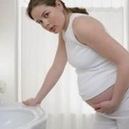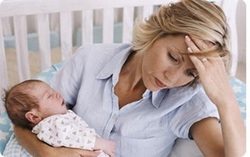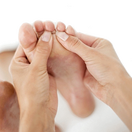Acupressure for prevention

Acupressure for the prevention of nausea and vomiting after epidural morphine for post-Cesarean section pain
relief
There have been numerous studies demonstrating the efficacy of acupressure on the P-6 (Neiguan) acupoint in preventing and alleviating nausea (1). However, researchers at the Department of Anesthesiology, Veterans General Hospital, Taiwan have recently demonstrated that this treatment has applications in childbirth. Nausea arid vomiting are common side effects following administration of epidural morphine for post-Cesarean section pain relief. The researchers therefore sought to evaluate the antiemetic effect of P-6 acupressure in women who were given epidural morphine for post-Cesarean section pain relief. In a randomised, double-blind and controlled trial, sixty women receiving epidural morphine for post-Cesarean section pain relief were allocated to receive either the acupressure bands on the P-6 acupoint on both arms, or placebo bands, before the administration of spinal anaesthesia and the women were monitored over the following 48 hours. The data revealed that the incidence of nausea and vomiting was significantly decreased from 43% and 27% in the control group, and from to 3% and 0% in the acupressure group. These results demonstrate that prophylactic use of acupressure bands bilaterally on the P-6 acupoint can significantly reduce the incidence of nausea and vomiting after epidural morphine for post-Cesarean section pain relief. (1) See ALTERNATIVES in health™ Vol1;1,4 (2) Ho C.-M.; Hseu S.-S.; Tsai S.-K.; Lee T.-Y. Effect of P-6 acupressure on prevention of nausea and vomiting after epidural morphine for post-Cesarean section pain relief. Acta Anaesthesiologica Scandinavica (Denmark) , 1996, 40/3 (372-375) Acupressure during cesarean

Acupressure,
Intravenous metoclopramide & nausea and vomiting
during spinal
anesthesia for cesarean section.
Nausea and vomiting occur frequently during cesarean section under spinal anesthesia. Metoclopramide reduces intraoperative nausea and vomiting, but not without potential side effects. Acupressure, a noninvasive variation of acupuncture that involves constant pressure on the wrist, has been suggested as an alternative method to prevent nausea and vomiting. The aim of this study was to compare acupressure and intravenous (IV) metoclopramide for the prevention of nausea and vomiting during elective cesarean section under spinal anesthesia. Seventy-five patients were studied in a randomized, prospective, double-blind comparative trial. Group I patients received acupressure bands + 2 mLIV saline, Group II patients received placebo wrist bands + 10 mg IV metoclopramide, and Group III patients received placebo wrist bands + 2 mL IV saline. Patients who received either acupressure or metoclopramide prior to initiation of spinal anesthesia for cesarean section had much less nausea than patients in the placebo group. Acupressure is an effective, non-pharmacologic method to reduce intraoperative nausea during elective cesarean section in the awake patient. Anesth Analg 1997 Feb;84(2):342-5, Stein DJ, Birnbach DJ, Danzer BI, Kuroda MM, Grunebaum A, Thys DM, Department of Anesthesiology, St. Luke's-Roosevelt Hospital Center, College of Physicians and Surgeons of Columbia University, New York, New York 10019, USA. |
Post partum depression (PPD)

Many new moms experience the "baby blues" after childbirth, which commonly include mood swings and crying spells that fade quickly. But some new moms experience a more severe, long-lasting form of depression known as postpartum depression. Rarely, an extreme form of postpartum depression known as postpartum psychosis develops after childbirth. It may occur soon after delivery or up to a year later. Most of the time, it occurs within the first 3 months after delivery. The exact causes of postpartum depression are partially unknown. The main reason are changes in hormone levels during and after pregnancy that may affect a woman’s mood. Many non-hormonal factors may also affect mood during this period: stress, self-perception of the body changes, worries and anxiety anout the baby, social relationship, depression or anxity in close family members. For several of these problems, reflexological treatments may give an help in supporting other therapies. Reflexology during labour

A study at the Gentofte Hospital in
Copenhagen revealed that reflexology is beneficial to women during the
labour of childbirth. 58 out of 60 women giving birth experienced
"outstanding pain relief using reflexology treatment", and 11 out
of 14 women were able to avoid surgery under general anaesthesia. Dr Carsten
Lenstrup was so impressed by the results that he said: "Taken as a
whole, the results are so good that am not in any doubt that reflexology can
give many women a better, easier and less painful delivery than they would
have had otherwise." (2)
The findings of the Gentofte study were supported by a further study carried out by Dr Gowri Motva at the Jeyrani Birth Centre on the effects of reflexology on pregnant women. 37 pregnant women completed a course of 10 reflexology treatments with remarkable effect. The average length of the first stage of labour was 5 hours whereas the text book average is 16 - 24 hours; the second stage of labour lasted an average of 16 minutes compared to the text book expectancy of 1 - 2 hours, and only 5.4% of the women who had reflexology treatment required emergency caesarian section compared to an average of 13% in Newham district which was the district where the study was conducted.(2) (1) Reported in "Berlingske Tidende" 15 July 1988 (2) Reflexology Association - Research Co-ordinator Kristine Walker |
COPYRIGHT by Dr. A. Virgili ReflexologyStudio - All rights reserved
